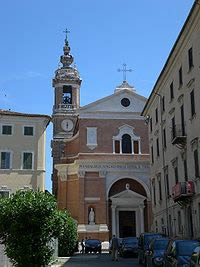
To know Jesi
Churches
Minster
 It was builded between XIII and XIV century by Giorgio Da Como and redone between 1732 and 1741 by Domenico
Barrigioni. In the inner church remain only two lions-stoup. Francesco Matellicani built the bell tower
between 1782 and 1784 like that erected in Loreto. The frontal was added in 1889. Inside there is a nave
and an hemispherical dome. During the XVIII century were opened many side domes enriched by paintings,
decorations and liturgical furniture.
It was builded between XIII and XIV century by Giorgio Da Como and redone between 1732 and 1741 by Domenico
Barrigioni. In the inner church remain only two lions-stoup. Francesco Matellicani built the bell tower
between 1782 and 1784 like that erected in Loreto. The frontal was added in 1889. Inside there is a nave
and an hemispherical dome. During the XVIII century were opened many side domes enriched by paintings,
decorations and liturgical furniture.
San Floriano Convent
It's the most historic and religious important Church of the town. Infact from the end of the XII century was dedicated to the Patron of Jesi and here went off the most important public cerimonies including the 4 May (Castelli di Jesi's Palio presentation as a token of submission to the town). The current aspect is the result of remake started in 1743 when Francesco Maria Ciaraffoni projected the inside parts of the church and the convent. It presents a great lantern and a never ended frontal. From 1851 Francesco Mancini painted the beautiful based oval dome decorated with Saint Francisco stuccoworks and frescoes. The church was deconsacrated in 1860 so first became a civic library, then a municipality art gallery and now is the Teatro Studio Valeria Moriconi's headquarter.
San Marco Church
It raises near from the town's boundary walls and is part of a enclosure monastery. It was erected in gothic style during the XIII century and presents a tripartite frontal opened by a rich rose window. Internally is divided in a nave and two side aisles that supported cross vaultes. Additionally there are some fourteenth-century frescoes that retracted the "Transito della Madonna", the "Madonna di Loreto", the "Crocefissione" and the "Annunciazione". During the restorations maded the last century (1854-1859) by the architect Angelo Angelucci and by the painters Silvestro Valeri and Marcello Sozzi was taken care of the vaultes and arches.
San Giovanni Battista Church
The build ascends at XIII century when started the urbanization of Terravecchia's ground. Apostolic Moncs rebuilt it at the end of '500 and in mid '600 was restructured by "Filipino Fathers. It presents a sober frontal but inside has sparkling decorations. Here are conserved some artworks including "Sangue Giusto", a Pietro da Rimini frescoes of 1333.
San Nicolò Church
It is the ancienter Jesi's build documented since the XII century. The Roman original forms were reshaped during the XIV century adding Gothic elements. Internally three apses aisles with cross vaultes supported by compound pilasters while the aisles had a Roman arches style. From here comes the frescoes "San Francesco" (1333) painted by Pietro from Rimini, now conserved at "Galleria Nazionale" of Urbino, and "L'Icona del sangue Giusto" now conserved in San Giovanni Battista church. The external apsidal chevet decoration is particularly original because it presents a series of little drop arches. The frontal is very simple with its central arched portal in polychromic marble and herringbone arched lintel in lateritious.
Other Churches:
- Santa Maria delle Grazie church: original of '400 but with the tower of XVII century and remade on XVIII century, conserves internally a frescoes of "Madonna della Misericordia" painted by Antonio from Fabriano.
- Ex female orphanage, with` the attached church, is an example of the XVIII century architecture designed by the roman Architect Virginio Bracci.
- San Pietro church was rebuilt during the XVIII century by architect Mattia Capponi with the frontal crowned by two litte bell towers.
- San Bernardo chapel, with an exuberant eighteenth-century internal, recently recovered and now periodically houses expositions and cultural manifestations.
- Santa Maria del Piano church: out of the town centre on the road to Macerata, internally it conserves own original vestiges.
- San Savino church: it is of the medieval age, near to the new church built at middle of XVI century.

